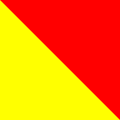O
15t letter o the Laitin alphabet From Wikipedia, the free encyclopedia
Remove ads
O (named o /ˈoʊ/, plural oes)[1] is the fifteent letter an a vowel in the ISO basic Latin alphabet.
| |||||||||||||||||||||||||||||||||
History
Its graphic fairm haes an aa remained fairly constant frae Phoenician times till the day. The name o the Phoenician letter wis ʿeyn, meanin "eye", an indeed its shape oreeginates simply as a drawin o a human ee (possibly inspired bi the correspondin Egyptian hieroglyph, c.f. Proto-Sinaitic script). Its oreeginal soond value wis that o a consonant, probably [ʕ], the soond representit bi the cognate Arabic letter letter ع ʿayn.
The uise o this Phoenician letter for a vowel soond is due tae the early Greek alphabets, which adoptit the letter as O "omicron" tae represent the vowel /o/. The letter wis adoptit wi this value in the Auld Italic alphabets, includin the early Latin alphabet. In Greek, a variation o the fairm later came tae distinguish this lang soond (Omega, meanin "large O") frae the short o (Omicron, meanin "smaa o"). Greek omicron gae rise tae the correspondin Cyrillic letter O an the early Italic letter tae runic runic ᛟ.
Even alphabets constructit "frae scratch", i.e. nae derived frae Semitic, uisually hae seemilar fairms tae represent this soond, e.g.; the creators o the Afaka an Ol Chiki scripts, each inventit in different pairts o the warld in the last century, baith attributit thair vowels for 'O' tae the shape o the mooth when makin this soond.
Remove ads
Uisage
The letter O is the fowert maist common letter in the Inglis leid. O is maist commonly associatit wi the Open-mid back roondit vowel [ɔ], Mid back roondit vowel [o̞] or close-mid back roondit vowel [o] in mony leids. This fairm is colloquially termed the "lang o" as in boat in Inglis, but it is actually maist eften a diphthong /oʊ/ (realized dialectically onywhaur frae [o] tae [əʊ]). In Inglis thare is a "short O" as in fox, which an aa haes several pronunciations. In maist dialects o Breetish Inglis, it is aither an open-mid back roondit vowel [ɔ] or an open back roondit vowel [ɒ]; in American Inglis, it is maist commonly an unroondit back tae a central vowel [ɑː] tae [a].
Common digraphs include 'oo', which represents aither /uː/, /ʊ/ or /ʌ/; 'oi' which teepically represents the diphthong /ɔɪ/, lik the pronunciation o 'oi' in "boil"; an 'ao', 'oe', an 'ou' which represent a variety o pronunciations dependin on context an etymology.
Ither leids uise O for various values, uisually back vowels which are at least pairtly open. Derived letters sic as Ö an Ø hae been creatit for the alphabets o some leids tae distinguish values that wur nae present in Latin an Greek, parteecularly roondit front vowels.
In the Internaitional Phonetic Alphabet, [o] represents the close-mid back roondit vowel.
Remove ads
Relatit letters an ither similar characters
- Ο ο : Greek letter Omicron
- О о : Cyrillic letter O
- Օ օ : Armenie letter O
- 0 : deegit zero, which is eften confused wi the letter O
- Ø ø : Latin letter Ø
- ∅ : empty set seembol
- ⌀ : diameter seembol
- ° : degree seembol
- º : masculine ordinal indicator (in Galician, Italian, Portuguese, an Spainyie)
Computin codes
- 1 An aa for encodins based on ASCII, includin the DOS, Windows, ISO-8859 an Macintosh faimilies o encodins.
Remove ads
Ither representations
| NATO phonetic | Morse code |
| Oscar |
 |
 |
[[File:Sign language {{{fingerspelling}}}.svg|90px]] |  |
| Seegnal banner | Banner semaphore | American manual alphabet (ASL fingerspellin) | Braille dots-135 |
References
Freemit airtins
Wikiwand - on
Seamless Wikipedia browsing. On steroids.
Remove ads


